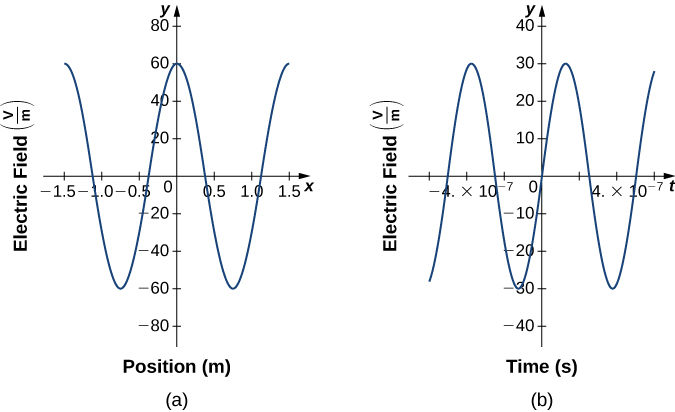| << Chapter < Page | Chapter >> Page > |
Instead of the AC generator, the antenna can also be driven by an AC circuit. In fact, charges radiate whenever they are accelerated. But while a current in a circuit needs a complete path, an antenna has a varying charge distribution forming a standing wave , driven by the AC. The dimensions of the antenna are critical for determining the frequency of the radiated electromagnetic waves. This is a resonant phenomenon and when we tune radios or TV, we vary electrical properties to achieve appropriate resonant conditions in the antenna.
From the illustration of the electric field given in [link] (a) of an electromagnetic wave at some instant in time, please state what the amplitude and wavelength of the given waveform are. Then write down the equation for this particular wave.
The amplitude is 60 V/m, while the wavelength in this case is 1.5 m. The equation is .
Now, consider another electromagnetic wave for which the electric field at a particular location is given over time by . What are the amplitude, frequency, and period? Finally, draw and label an appropriate graph for this electric field.
The amplitude is 30 V/m, while the frequency is 2.0 MHz and hence the period is 5.0 × 10 −7 s. The graph should be similar to that in [link] (b).

Electromagnetic waves carry energy away from their source, similar to a sound wave carrying energy away from a standing wave on a guitar string. An antenna for receiving EM signals works in reverse. And like antennas that produce EM waves, receiver antennas are specially designed to resonate at particular frequencies.
An incoming electromagnetic wave accelerates electrons in the antenna, setting up a standing wave. If the radio or TV is switched on, electrical components pick up and amplify the signal formed by the accelerating electrons. The signal is then converted to audio and/or video format. Sometimes big receiver dishes are used to focus the signal onto an antenna.
In fact, charges radiate whenever they are accelerated. When designing circuits, we often assume that energy does not quickly escape AC circuits, and mostly this is true. A broadcast antenna is specially designed to enhance the rate of electromagnetic radiation, and shielding is necessary to keep the radiation close to zero. Some familiar phenomena are based on the production of electromagnetic waves by varying currents. Your microwave oven, for example, sends electromagnetic waves, called microwaves, from a concealed antenna that has an oscillating current imposed on it.
There is a relationship between the - and -field strengths in an electromagnetic wave. This can be understood by again considering the antenna just described. The stronger the -field created by a separation of charge, the greater the current and, hence, the greater the -field created.

Notification Switch
Would you like to follow the 'College physics for ap® courses' conversation and receive update notifications?